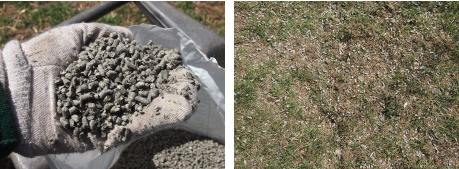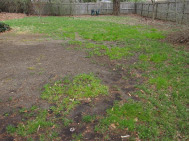 We recently answered a call from a client who has had difficulty in getting areas of his lawn re-established .
We recently answered a call from a client who has had difficulty in getting areas of his lawn re-established .
Upon arrival, and inspection of the site, we noticed a few things working against the homeowner.
1.- An incline in the grade of the soil
2.- Soil compaction
3.- A lack of an irrigation system
4.- Shade from a large maple tree, and its’ root system.
How did we address these challenges?
1.- Core aeration, ( covered in our last article), to help loosen the compacted soil. We also like to add repeated applications of Gypsum to the soil, to aid in the de-compaction process.
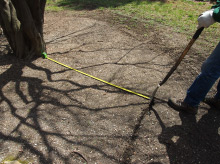 2.- Creating a bed around the large maple was important because it differentiated the area of the maple tree roots and where the lawn started. A tape measure is used to make an even bed around the tree base. The edge of the bed will aid in keeping the mulch around the tree, as well as act as a starting point for the grass section of the yard. It is also gives a much neater appearance
2.- Creating a bed around the large maple was important because it differentiated the area of the maple tree roots and where the lawn started. A tape measure is used to make an even bed around the tree base. The edge of the bed will aid in keeping the mulch around the tree, as well as act as a starting point for the grass section of the yard. It is also gives a much neater appearance
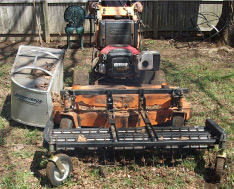 3.- We scratched the soil, mechanically with a 48” tine-rake device (at tached to a lawnmower) to create grooves in the soil which will hold the seeds in place, avoiding run-off, during watering and rainfall. We then manually applied an Athletic Field (draught resistant) turf grass seed, due to the lack of an Irrigation System
3.- We scratched the soil, mechanically with a 48” tine-rake device (at tached to a lawnmower) to create grooves in the soil which will hold the seeds in place, avoiding run-off, during watering and rainfall. We then manually applied an Athletic Field (draught resistant) turf grass seed, due to the lack of an Irrigation System
4.- We then covered large bare spots with Straw Hay, and smaller areas with Penn Mulch. These two products aid in germination of the grass seed by keeping the seed moist. The more evenly moist the seed is kept, the faster it will germinate
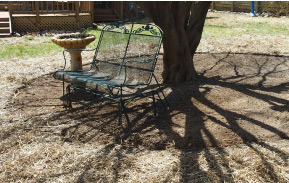 5.- Next, we recommended a watering schedule for the homeowner. The quantity is dependent on many factors, unique to each home, one being the amount of rain or sun the lawn is exposed to. The watering has to be watched very carefully for the first three weeks. The new grass seed will emerge as the warmer weather ensues.
5.- Next, we recommended a watering schedule for the homeowner. The quantity is dependent on many factors, unique to each home, one being the amount of rain or sun the lawn is exposed to. The watering has to be watched very carefully for the first three weeks. The new grass seed will emerge as the warmer weather ensues.
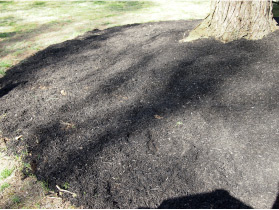 As a final note, adding mulch around a tree can aid in moisture retention, weed control, and insulating roots in colder temperatures. The mulch layer should not exceed 2” – 3” in depth, as to not affect the water absorption. Mulch should also not be piled up around the trunk, so it doesn’t rot the bark.
As a final note, adding mulch around a tree can aid in moisture retention, weed control, and insulating roots in colder temperatures. The mulch layer should not exceed 2” – 3” in depth, as to not affect the water absorption. Mulch should also not be piled up around the trunk, so it doesn’t rot the bark.
By: Everett Fink, Edited by Elysse Fink
 Everett Fink is a Certified Rutgers Master Gardener, Certified Pesticide applicator, and N.J. State licensed Home Improvement Contractor. Everett was designated Top Tier Designer at Sponzilli Landscape, and currently Owns Property Details LLC, in New Jersey. Property Details has a Container Gardening Division designing and maintaining Pools, Patios, and Porches with beautiful flowers, and foliage.
Everett Fink is a Certified Rutgers Master Gardener, Certified Pesticide applicator, and N.J. State licensed Home Improvement Contractor. Everett was designated Top Tier Designer at Sponzilli Landscape, and currently Owns Property Details LLC, in New Jersey. Property Details has a Container Gardening Division designing and maintaining Pools, Patios, and Porches with beautiful flowers, and foliage.






























